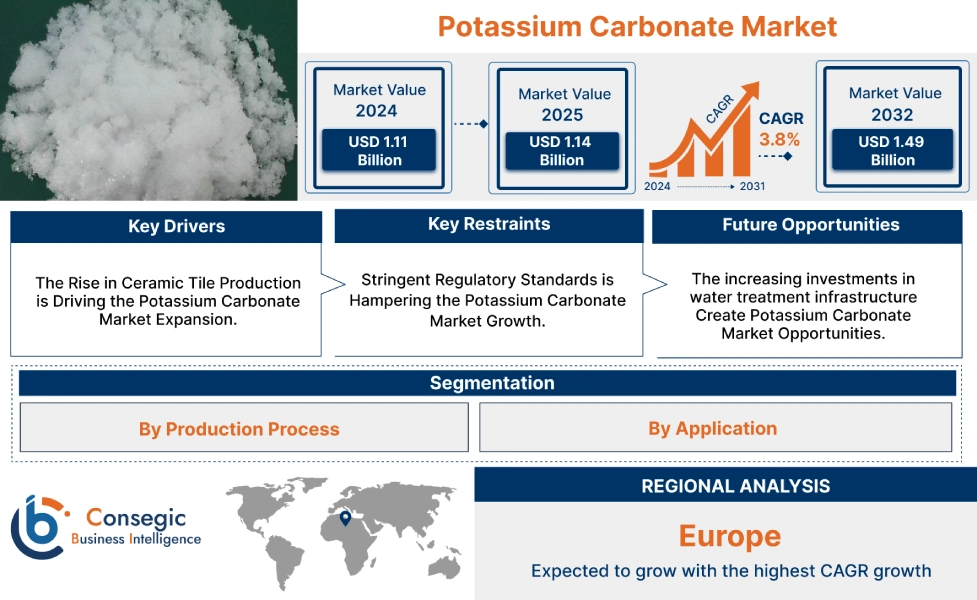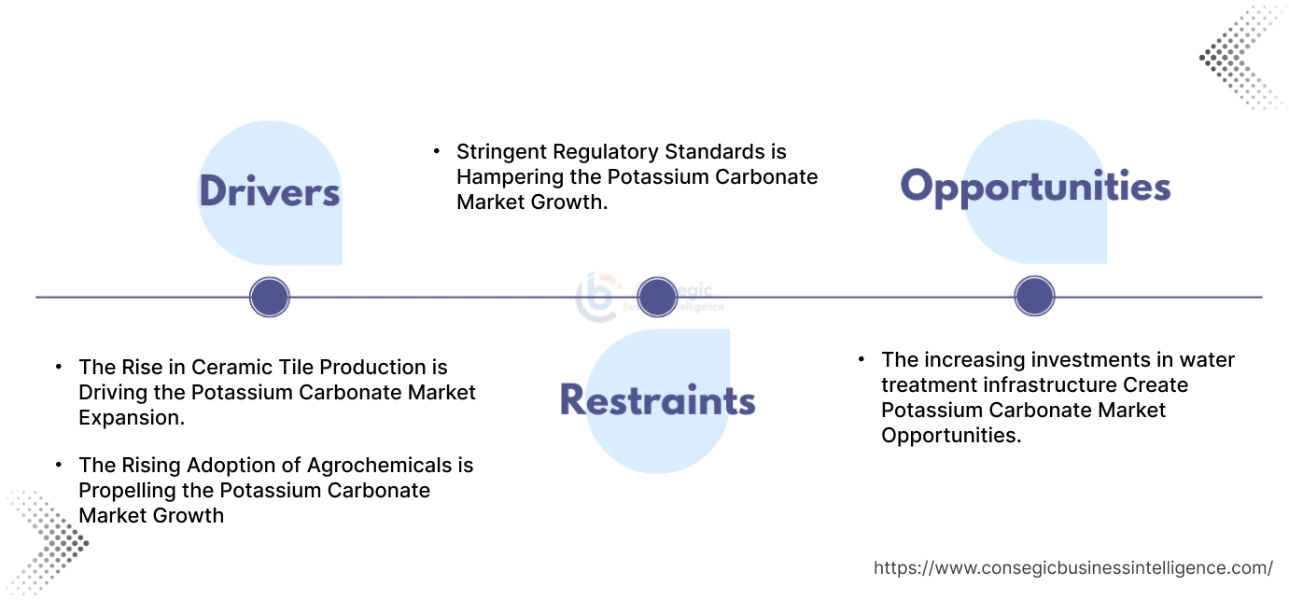Potassium Carbonate Market Size:
The Potassium Carbonate Market size is growing with a CAGR of 3.8% during the forecast period (2025-2032), and the market is projected to be valued at USD 1.49 Billion by 2032 from USD 1.11 Billion in 2024. Additionally, the market value for 2025 is attributed to USD 1.14 Billion.
Potassium Carbonate Market Scope & Overview:
Potassium Carbonate (K2CO3) is a white, water-soluble compound that forms a strong alkaline solution. The compound is also known for its historic names such as potash, pearl ash, or salt of tarter. It shows characteristics such as strong ability to neutralize acids, tendency to absorb moisture from air, and others. The market is categorized into production process, and application. The production process segment is further classified into electrolysis, ion exchange, ash method, and others. Similarly, the application segment is classified into glass & ceramic, agrochemicals, water treatment, food additives, pharmaceutical products, soaps & detergents, dyes & inks, and others.
Potassium Carbonate Market Dynamics - (DRO) :
Key Drivers:
The Rise in Ceramic Tile Production is Driving the Potassium Carbonate Market Expansion.
Potassium carbonate plays a major role in the production of ceramic tiles. It is primarily used as a flux and color modifier in glazes. In the manufacturing of tiles, it helps lower the melting temperature of glazes and influence the final color. The rise in the production of ceramic tiles is influencing the use of this compound.
For instance,
- The data in the Vibrant Gujrat journal, states that the China is one of the leading ceramic tile manufacturer and exporter worldwide in 2021. It produced 8.86 billion square meters of ceramic tiles and exported approximately 601 million square meters.
Thus, the rise in the production of tiles that are made from ceramic is influencing the potassium carbonate market demand.
The Rising Adoption of Agrochemicals is Propelling the Potassium Carbonate Market Growth
Potassium carbonate plays a major role in providing a major source of potassium for the nutrition of plant and acts as a significant agent in the production of agrochemicals such as fertilizers and pesticides among others. As a highly soluble potassium form, it is efficiently absorbed by the plant enhancing the overall health of the plant. Additionally, along with fertilizers, these compounds are used in pesticides and insecticides to maintain the pH of the soil and prevent the plants form pests and insects. The rise in the use of pesticides is driving the use of this compound.
For instance,
- The data by FAO, states that total pesticide use in agriculture reached 3.70 Billion tons, marking a 4% increase compared to 2021. This trend reflects a growth of 13% from 2012.
Overall, the growing adoption of agrochemicals such as pesticides is influencing the potassium carbonate market expansion.
Key Restraints:
Stringent Regulatory Standards is Hampering the Potassium Carbonate Market Growth.
The Potassium Carbonate industry faces significant hurdles due to stringent regulatory standards imposed by various regulatory bodies worldwide. These regulations, designed to ensure product safety and efficacy, mainly involve rigorous testing, extensive documentation, and lengthy approval processes. Compliance with these standards is time-consuming and costly, particularly for smaller companies or those developing novel ingredients.
Additionally, changes in regulatory guidelines or the introduction of stricter regulations disrupt established processes and require significant investments in research, development, and manufacturing to meet the new standards. These factors contribute to increased costs, delayed product launches, and limited market access, ultimately hindering market revenue.
Future Opportunities :
The increasing investments in water treatment infrastructure Create Potassium Carbonate Market Opportunities.
As various countries focus on the development and modernization of drinking facilities, and wastewater management systems, there is a rise in the requirement for the effective compounds for water softening, and adjustment of the pH. Potassium carbonate helps in the removal of hardness of water and neutralizes the acidic water. The rise in the water treatment infrastructure funding in enhancing the use of this compound.
For instance,
- In September 2024, the S. Environmental Protection Agency announced the availability of USD 7.5 billion of Water Infrastructure Finance and Innovation Act (WIFIA) funding. The main aim is to protect waterways including drinking water sources and implement cleaning practices.
Thus, due to the aforementioned factors, increasing focus on investment for water to create Potassium Carbonate market opportunities.
Potassium Carbonate Market Segmental Analysis :
By Production Process:
Based on Production Process, the market is categorized into electrolysis, ion exchange, ash method, and others.
Trend in Production Process
- The growing trend for the production of high purity compound is influencing the use of electrolysis production process.
The electrolysis segment accounted for the largest Potassium Carbonate market share in 2024 and is expected to grow at the fastest CAGR over the forecast period.
- The electrolysis method is primarily used because it helps in the production of potassium carbonate that is of high purity and exceptional efficiency.
- Manufacturers are introducing novel facilities that use electrolysis method for the development of this compound.
- For instance, Vynova Group introduced a new plant for the production of liquid potassium carbonate in Belgium.
- Additionally, there is constant research and development work undertaken for the production of this compound through advanced electrolysis methods.
- Thus, as per the market analysis, the rise in the use of electrolysis method is influencing the potassium carbonate market trends and share at present and in the coming years.
By Application:
The Application segment is categorized into glass & ceramic, agrochemicals, water treatment, food additives, pharmaceutical products, soaps & detergents, dyes & inks, and others.
Trends in the Application
- There is a growing use of glass containers for various applications that is influencing the use of this compound.
- The trend for developed water treatment infrastructure and use of novel chemicals is influencing the use of this compound.
The glass & ceramic resistant coatings segment accounted for the largest potassium carbonate market share of 39.11% in 2024.
- In the glass and ceramics industries, potassium carbonate is mainly used as a fluxing agent.
- This compound also enhances the key properties that include the clarity and strength of glass.
- This makes them important for applications such as specialty glass, optical lenses, and high-quality ceramic glazes.
- The rise in the production of these tiles is influencing the use of this compound.
- For instance, according to Vibrant Gujrat journal, India is the second largest producer of ceramic tiles with the production of USD 2.55 Billion in 2021.
- Thus, as per the analysis, the rise in the use of glass and ceramic products is influencing the potassium carbonate market trends.
The water treatment segment is expected to grow at the fastest CAGR over the forecast period.
- In the treatment of water, potassium carbonate is an important compound that is used for the applications of pH adjustment and the softening of water.
- The alkaline nature of the compound enhances the level of pH of the acidic water making it less corrosive and suitable for numerous areas.
- Additionally, it helps in softening the hard water which prevents the buildup of scale in pipes and equipment, therefore improving the quality of water in water treatment infrastructure.
- As a result, based on the potassium carbonate market analysis, owing to the aforementioned factors, the water treatment segment is expected to have lucrative trends over the forecast period.
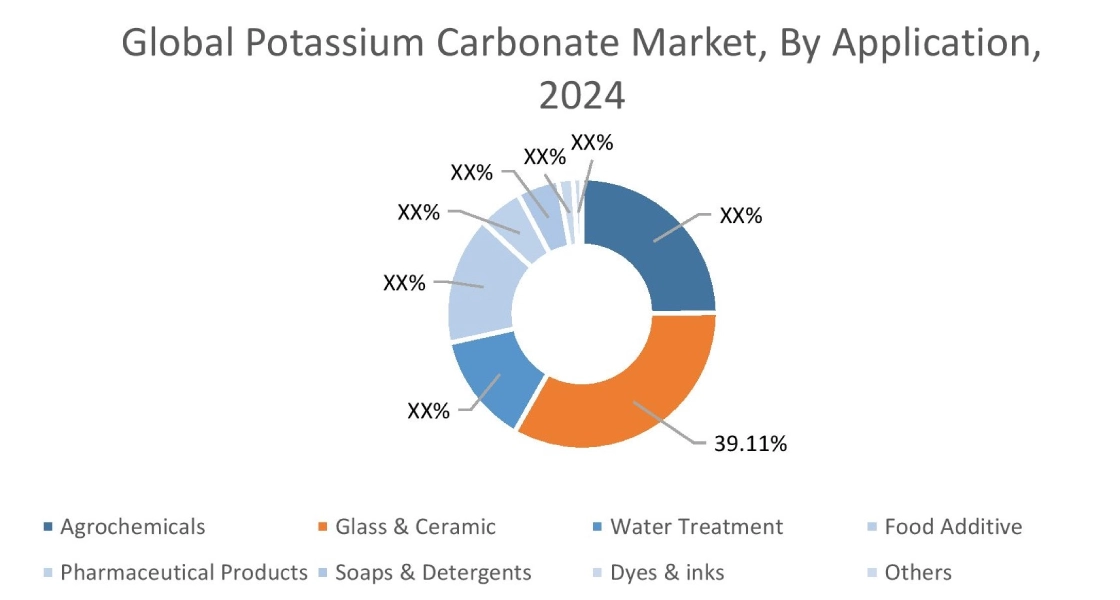
Regional Analysis:
The regional segment includes North America, Europe, Asia Pacific, the Middle East and Africa, and Latin America.
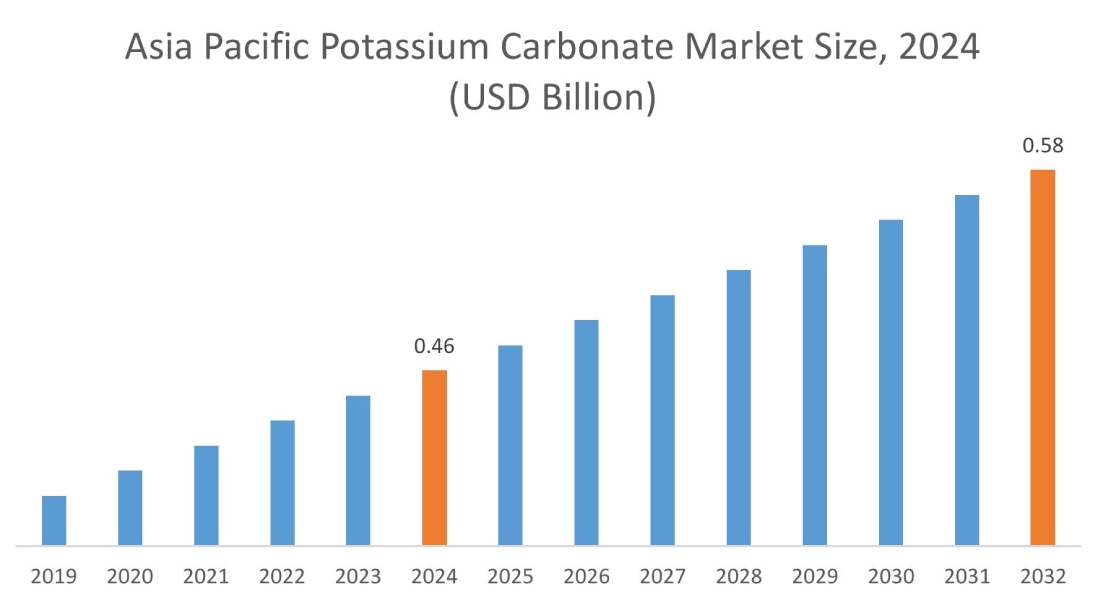
In 2024, Asia Pacific accounted for the highest market share at 41.23% and was valued at USD 0.46 Billion and is expected to reach USD 0.58 Billion in 2032. In Asia Pacific, China accounted for the market share of 37.12% during the base year of 2024. The Asia Pacific (APAC) region is dominating due to the growing demand from the glass & ceramic sector. Potassium carbonate is used as a fluxing agent that is utilized to lower the melting point of silica considerately. This leads to energy efficiency during the manufacturing process as well as offering benefits such as improvement in durability, clarity of the finalized glass and ceramic products. This need is further driven by the region's focus towards infrastructure development that leads to large need for vast quantities of ceramic tiles amongst others.
- For instance, according to Ceramic World Web, the consumption growth rate of ceramic tiles grew at an annual average growth rate of 2.2% from 2023 to 2024.
Consequently, based on the potassium carbonate market analysis, the glass and ceramic segments in APAC are expected to remain dominant over the forecast period as well.
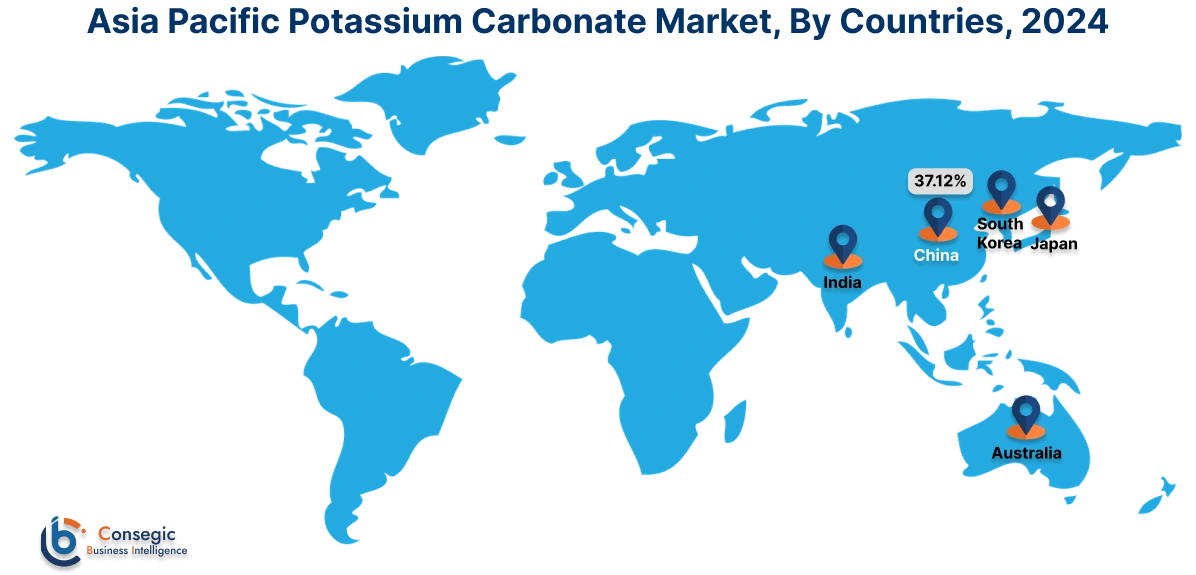
In Europe, the Potassium Carbonate industry is experiencing the fastest growth with a CAGR of 5.1% over the forecast period. In Europe, this compound is widely utilized in the water treatment sector due to its focus on strict environmental regulations as well as an aim on maintaining high quality water for both industrial and municipal uses. The compound is important for pH adjustment and softening. This helps to remove hardness-causing ions, thereby complying with European standards. The ongoing urbanization across Europe creates lucrative opportunities for this compound in wastewater, attributing to the region’s market growth. Furthermore, as per the market analysis, Europe's focus on sustainable chemicals makes this compound a suitable option for water reuse in the region.
The agrochemicals segment in North America is lucrative for the utilization of potassium carbonate due to the large agricultural sector in the region. This compound is one of the key elements required to produce fertilizers. These fertilizers supply necessary potassium to plants, thereby leading to improving quality, amongst others. The compounds alkaline properties make it effective for regulating soil pH, particularly in organic farming. Furthermore, it also acts as a fungicide against plant diseases. Based on the market analysis, the growing adoption of sustainable agricultural practices is having a positive impact on the Potassium Carbonate market demand.
The Latin American market for potassium carbonate is expected to witness significant trends primarily attributed to expanding pharmaceutical industry. The increasing focus on healthcare access, local drug manufacturing, and the rising prevalence of chronic diseases across countries like Brazil and Argentina are driving the demand for pharmaceutical-grade chemicals. This compound, utilized as a pH adjuster, buffering agent, and in the synthesis of various active pharmaceutical ingredients and formulations, benefits directly from this expansion. As these nations invest more in healthcare infrastructure and local production capabilities to reduce reliance on imports, the need for high-quality excipients and chemical reagents like potassium carbonate will intensify potential for the market.
The Middle East and Africa market is experiencing modest, influenced by developing industrial sectors and rising consumer demand for hygiene products. Within this region, the soap and detergents segment stand out as a key driver for potassium carbonate consumption. The growing awareness for hygiene solutions is increasing the demand for personal care and household cleaning products, correspondingly supporting the need for liquid soaps and specialized detergents. Furthermore, a rising awareness of health and hygiene, amplified by public health initiatives, directly translates into higher sales of these products. This growing consumer base, coupled with the establishment of local manufacturing facilities for soaps and detergents in countries across the MEA, directly fuels the demand for the compound as a vital raw material, contributing to the region's overall market trends.
Top Key Players and Market Share Insights:
The Global Potassium Carbonate Market is highly competitive with major players providing products to the national and international markets. Key players are adopting several strategies in research and development (R&D) and product innovation to hold a strong position in the global Potassium Carbonate market. Key players in the Potassium Carbonate industry include
- UNID GLOBAL Corporation (Korea)
- Esseco Group (Italy)
- Foodchem International Corporation (China)
- Armand products (U.S.)
- Zhejiang Dayang (China)
- Oxy (Occidental Petroleum Corporation) (U.S.)
- Gujarat Alkalies and Chemicals Limited (India)
- Vynova Group (Belgium)
- AGC Chemicals (U.S.)
- JSC Pikalevskaya Soda (Russia)
Potassium Carbonate Market Report Insights :
| Report Attributes | Report Details |
| Study Timeline | 2019-2032 |
| Market Size in 2032 | USD 1.49 Billion |
| CAGR (2025-2032) | 3.8% |
| By Production Process |
|
| By Application |
|
| By Region |
|
| Key Players |
|
| North America | U.S. Canada Mexico |
| Europe | U.K. Germany France Spain Italy Russia Benelux Rest of Europe |
| APAC | China South Korea Japan India Australia ASEAN Rest of Asia-Pacific |
| Middle East and Africa | GCC Turkey South Africa Rest of MEA |
| LATAM | Brazil Argentina Chile Rest of LATAM |
| Report Coverage |
|
Key Questions Answered in the Report
How big is the Potassium Carbonate market? +
In 2024, the Potassium Carbonate market is USD 1.11 Billion.
Which is the fastest-growing region in the Potassium Carbonate market? +
Europe is the fastest-growing region in the Potassium Carbonate market.
What specific segmentation details are covered in the Potassium Carbonate market? +
By Production Process, and Application segmentation details are covered in the Potassium Carbonate market.
Who are the major players in the Potassium Carbonate market? +
UNID GLOBAL Corporation (Korea), Oxy (Occidental Petroleum Corporation) (U.S.), Gujarat Alkalies and Chemicals Limited (India) are some of the major players in the market.
